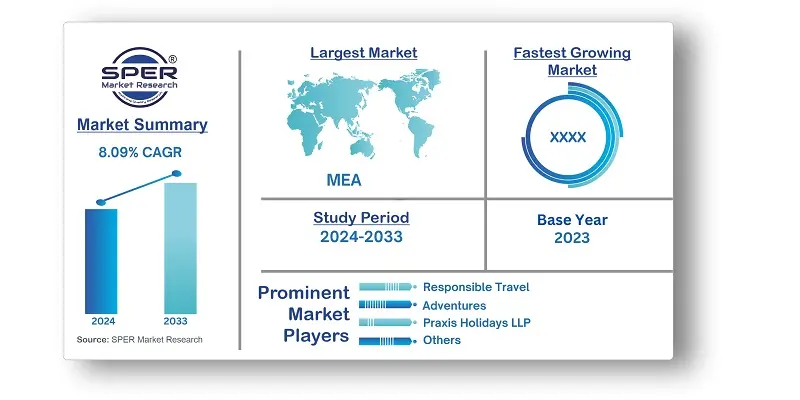
GCC Outbound Tourism Market Growth, Size, Trends, Share, Revenue, Demand and Future Outlook
GCC Outbound Tourism Market Size- By Tourist Type, By Age Distribution, By Tourism Type, By Traveler Type- Regional Outlook, Competitive Strategies and Segment Forecast to 2033
| Published: Apr-2024 | Report ID: TRAT2401 | Pages: 1 - 158 | Formats*: |
| Category : Travel & Tourism | |||
- Big Five Tours & Expeditions declared the grand opening of Galapagos.com, a website dedicated to eco-friendly travel. The website has the name of the Galapagos Islands, which are home to some of the rarest species on the planet and are where Darwin's theory of evolution originated.
- A single tourist visa will be available to all member states of the Gulf Cooperation Council (GCC) by 2025. This initiative is in line with the GCC 2030 tourism strategy, which aims to increase tourism by 7% yearly and establish the area as a top global tourist destination


| Report Metric | Details |
| Market size available for years | 2020-2033 |
| Base year considered | 2023 |
| Forecast period | 2024-2033 |
| Segments covered | By Tourist Type, By Age Distribution, By Tourism Type, By Traveler Type |
| Regions covered | Southern Region, Northern Region, Eastern Region, Western Region |
| Companies Covered | Big Five Tours & Expeditions Inc., Farhat Tours & Transfers S.P.C., G Adventures, Praxis Holidays LLP, Greenloons LLC, Responsible Travel, Royal Arabian Destination Management, and Steppes Travel. |
- Travel Agencies and Tour Operators
- Airlines and Aviation Industry
- Hospitality and Accommodation Providers
- Government Tourism Boards and Authorities
- Business Travelers
- Leisure Travelers
- Adventure and Eco-Tourism Enthusiasts
- Luxury Travel Segment
- Millennials and Generation Z Travelers
- Senior Citizens and Retirees
| By Tourist Type: |
|
| By Age Distribution: |
|
| By Tourism Type: |
|
| By Traveler Type: |
|
- GCC Outbound Tourism Market Size (FY’2024-FY’2033)
- Overview of GCC Outbound Tourism Market
- Segmentation of GCC Outbound Tourism Market By Tourist Type (Domestic, International)
- Segmentation of GCC Outbound Tourism Market By Age Distribution (Under 18 years, 18-25 years, 26-35 years, 36-45 years, 46-55 years, Above 55 years)
- Segmentation of GCC Outbound Tourism Market By Tourism Type (Holiday, VFR (Visit Friends and Relatives), Business, Others)
- Segmentation of GCC Outbound Tourism Market By Traveler Type (Independent Traveller, Tour Group, Package Traveller)
- Expansion Analysis of GCC Outbound Tourism Market
- Problems and Obstacles in GCC Outbound Tourism Market
- Competitive Landscape in the GCC Outbound Tourism Market
- Impact of COVID-19 and Demonetization on GCC Outbound Tourism Market
- Details on Current Investment in GCC Outbound Tourism Market
- Competitive Analysis of GCC Outbound Tourism Market
- Prominent Players in the GCC Outbound Tourism Market
- SWOT Analysis of GCC Outbound Tourism Market
- GCC Outbound Tourism Market Future Outlook and Projections (FY’2024-FY’2033)
- Recommendations from Analyst
1.1. Scope of the report1.2. Market segment analysis
2.1. Research data source2.1.1. Secondary Data2.1.2. Primary Data2.1.3. SPER’s internal database2.1.4. Premium insight from KOL’s2.2. Market size estimation2.2.1. Top-down and Bottom-up approach2.3. Data triangulation
4.1. Driver, Restraint, Opportunity and Challenges analysis4.1.1. Drivers4.1.2. Restraints4.1.3. Opportunities4.1.4. Challenges4.2. COVID-19 Impacts of the GCC Outbound Tourism Market
5.1. SWOT Analysis5.1.1. Strengths5.1.2. Weaknesses5.1.3. Opportunities5.1.4. Threats5.2. PESTEL Analysis5.2.1. Political Landscape5.2.2. Economic Landscape5.2.3. Social Landscape5.2.4. Technological Landscape5.2.5. Environmental Landscape5.2.6. Legal Landscape5.3. PORTER’s Five Forces5.3.1. Bargaining power of suppliers5.3.2. Bargaining power of buyers5.3.3. Threat of Substitute5.3.4. Threat of new entrant5.3.5. Competitive rivalry5.4. Heat Map Analysis
6.1. GCC Outbound Tourism Market Manufacturing Base Distribution, Sales Area, Product Type6.2. Mergers & Acquisitions, Partnerships, Product Launch, and Collaboration in GCC Outbound Tourism Market
7.1. GCC Outbound Tourism Market Value Share and Forecast, By Tourist Type, 2024-20337.2. Domestic7.3. International
8.1. GCC Outbound Tourism Market Value Share and Forecast, By Age Distribution, 2024-20338.2. Under 18 years8.3. 18-25 years8.4. 26-35 years8.5. 36-45 years8.6. 46-55 years8.7. Above 55 years
9.1. GCC Outbound Tourism Market Value Share and Forecast, By Tourism Type, 2024-20339.2. Holiday9.3. VFR (Visit Friends and Relatives)9.4. Business9.5. Others
10.1. GCC Outbound Tourism Market Value Share and Forecast, By Traveler Type, 2024-203310.2. Independent Traveller10.3. Tour Group10.4. Package Traveller
11.1. GCC Outbound Tourism Market Size and Market Share
12.1. GCC Outbound Tourism Market Size and Market Share By Tourist Type (2020-2026)12.2. GCC Outbound Tourism Market Size and Market Share By Tourist Type (2027-2033)
13.1. GCC Outbound Tourism Market Size and Market Share By Age Distribution (2020-2026)13.2. GCC Outbound Tourism Market Size and Market Share By Age Distribution (2027-2033)
14.1. GCC Outbound Tourism Market Size and Market Share By Tourism Type (2020-2026)14.2. GCC Outbound Tourism Market Size and Market Share By Tourism Type (2027-2033)
15.1. GCC Outbound Tourism Market Size and Market Share By Traveler Type (2020-2026)15.2. GCC Outbound Tourism Market Size and Market Share By Traveler Type (2027-2033)
16.1. GCC Outbound Tourism Market Size and Market Share By Region (2020-2026)16.2. GCC Outbound Tourism Market Size and Market Share By Region (2027-2033)16.3. Eastern16.4. Western16.5. Northern16.6. Northern
17.1. Big Five Tours & Expeditions Inc.17.1.1. Company details17.1.2. Financial outlook17.1.3. Product summary17.1.4. Recent developments17.2. Farhat Tours & Transfers S.P.C.17.2.1. Company details17.2.2. Financial outlook17.2.3. Product summary17.2.4. Recent developments17.3. G Adventures, Praxis Holidays LLP17.3.1. Company details17.3.2. Financial outlook17.3.3. Product summary17.3.4. Recent developments17.4. Greenloons LLC17.4.1. Company details17.4.2. Financial outlook17.4.3. Product summary17.4.4. Recent developments17.5. Responsible Travel17.5.1. Company details17.5.2. Financial outlook17.5.3. Product summary17.5.4. Recent developments17.6. Royal Arabian Destination Management17.6.1. Company details17.6.2. Financial outlook17.6.3. Product summary17.6.4. Recent developments17.7. Steppes Travel17.7.1. Company details17.7.2. Financial outlook17.7.3. Product summary17.7.4. Recent developments17.8. Others
SPER Market Research’s methodology uses great emphasis on primary research to ensure that the market intelligence insights are up to date, reliable and accurate. Primary interviews are done with players involved in each phase of a supply chain to analyze the market forecasting. The secondary research method is used to help you fully understand how the future markets and the spending patterns look likes.
The report is based on in-depth qualitative and quantitative analysis of the Product Market. The quantitative analysis involves the application of various projection and sampling techniques. The qualitative analysis involves primary interviews, surveys, and vendor briefings. The data gathered as a result of these processes are validated through experts opinion. Our research methodology entails an ideal mixture of primary and secondary initiatives.



Frequently Asked Questions About This Report
PLACE AN ORDER
Year End Discount
Sample Report
Pre-Purchase Inquiry
NEED CUSTOMIZATION?
Request CustomizationCALL OR EMAIL US
100% Secure Payment






Related Reports
Our Global Clients
Our data-driven insights have influenced the strategy of 200+ reputed companies across the globe.






















